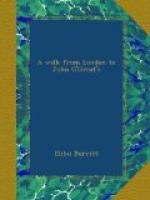This irrigation is performed through the medium of a small steam engine and sixteen hydrants, so posted and supplied with hose as to reach every square foot of the 170 acres. The water used for this purpose is mostly, if not entirely, supplied from the draining pipes, even in the dryest season. The manure thus liquified is made by a comparatively small number of animals. Calves to the value of 50 pounds are bought, and fat stock to that of 500 pounds are sold annually. They are all stabled throughout the year, except in harvest time, when they are turned out for a few weeks to rowen feed. The calves are housed until a year old in a large stedding by themselves. They are then transferred to another building, and put upon “the boards;” that is in a long stable or cowhouse, with a flooring of slats, through which the manure drops into a cellar below, made water-tight. Here the busiest little engine in the world is brought to bear upon it, with all its faculties of suction and propulsion. Through one pipe it forces fresh water in upon this mass of manure, which, when liquified, runs down into a subterranean cistern or reservoir capable of holding over 100,000 gallons. From this it is propelled into any field to be irrigated. To prevent any sediment in the great reservoir, or to make an even mixture of the liquified manure, a hose is attached to the engine, and the other end dropped into the mass. Through this a constant volume of air is propelled with such force as to set the whole boiling and foaming like a little cataract. One man at the engine and two at the hose in the distant field perform the whole operation. The chapped and “baky” surface of the farm is thus softened and enriched at will, and rendered productive.




